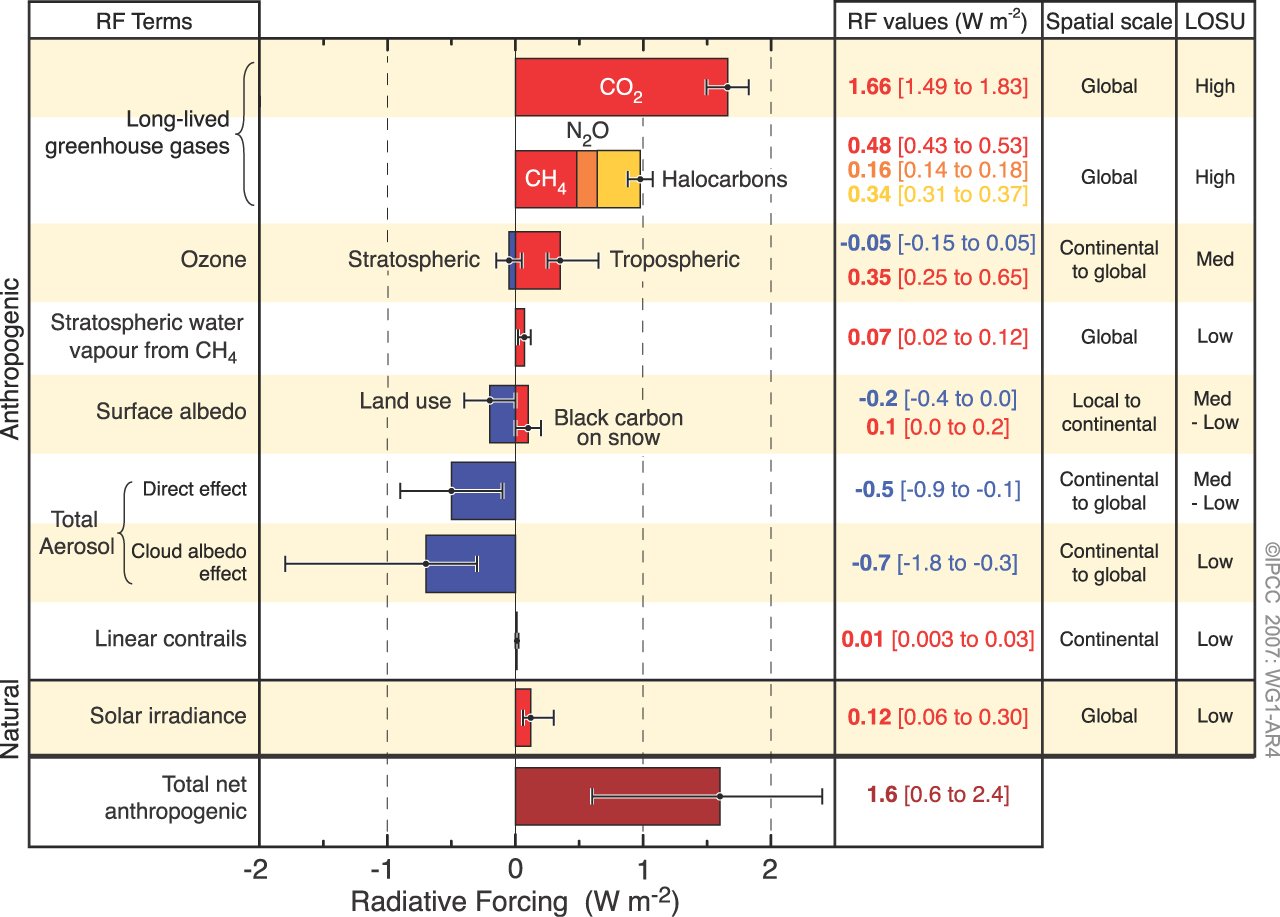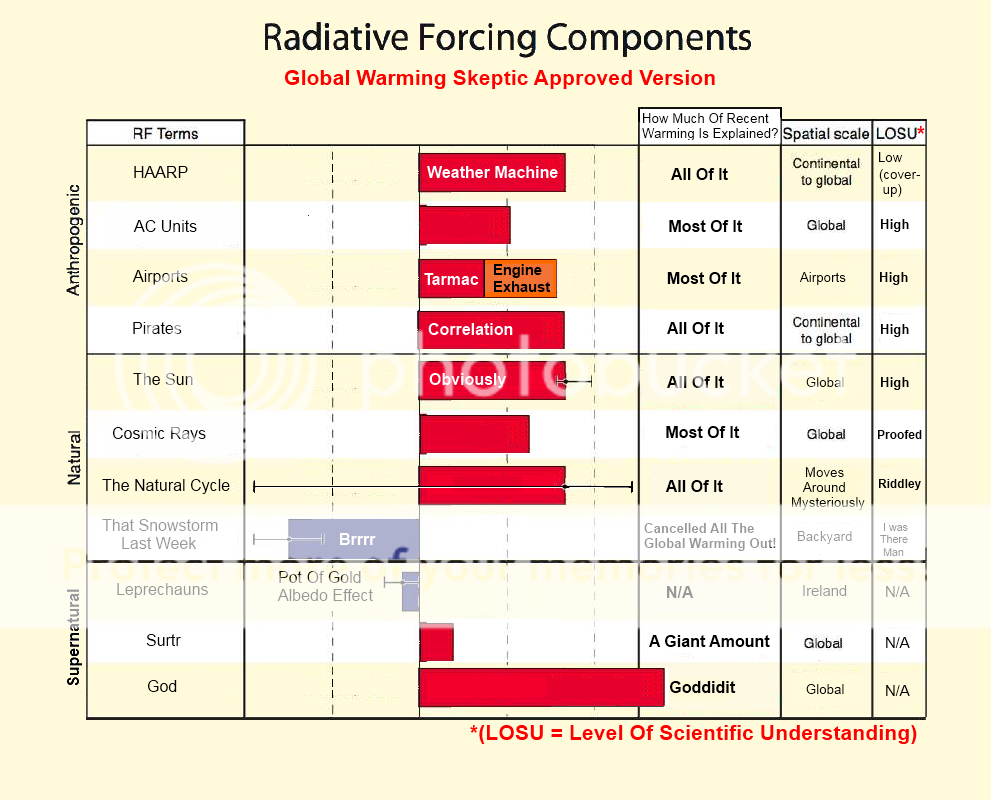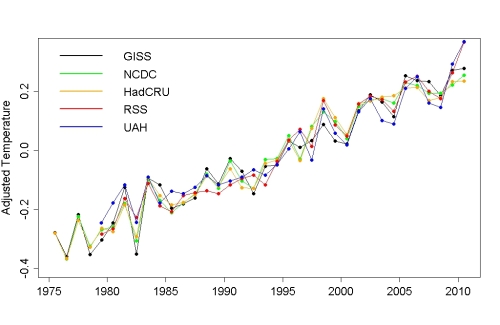A Case Study of a Climate Scientist Skeptic
Posted on 4 February 2011 by dana1981
Previously, in A Case Study in Climate Science Integrity (which was picked up and re-published by The Guardian Environment Network), we qualitatively examined two errors which led the Universal Ecological Fund (Fundaciíon Ecológical Universal [FEU-US]) and Dr. Richard Lindzen to arrive at diametrically opposed, but equally wrong conclusions. Here is Lindzen's (emphasis added):
"According to the UN’s Intergovernmental Panel on Climate Change, the greenhouse forcing from man made greenhouse gases is already about 86% of what one expects from a doubling of CO2 (with about half coming from methane, nitrous oxide, freons and ozone), and alarming predictions depend on models for which the sensitivity to a doubling for CO2 is greater than 2C which implies that we should already have seen much more warming than we have seen thus far"
In both publications, thermal inertia and negative forcings were neglected. Both performed calculations which accounted for the positive anthropogenic forcings (carbon dioxide, methane, and other greenhouse gases), but neglected these two factors. The difference is that while the FEU-US completely ignored them, Lindzen did mention each factor in a halfhearted effort to justify neglecting them. But before we get into the details, it's worthwhile to examine the history of Lindzen's "we should have seen much more warming" argument.
A Brief History in Lindzen Time
Dr. Lindzen seems to have first made this argument in a 2002 letter to his local mayor in Newton, Massachusetts.
"the impact on the heat budget of the Earth due to the increases in CO2 and other man influenced greenhouse substances has already reached about 75% of what one expects from a doubling of CO2, and the temperature rise seen so far is much less (by a factor of 2-3) than models predict"
In 2005, Lindzen made the same argument in testimony to the UK Parliament House of Lords Economic Affairs Committee. He later repeated the argument on National Public Radio (NPR) in 2006, again on NPR in 2007 in a public debate which included Gavin Schmidt and Michael Crichton, in an Energy & Environment-published paper in 2007, in an article in 2008, another article in 2009, and of course the 2011 article examined in the Case Study and re-published uncritically at WattsUpWithThat and many other "skeptic" media sources. Suffice it to say, Lindzen makes this argument frequently.
Lindzen's argument has also been rebutted several times, including by Coby Beck in 2006 and Stefan Rahmstorf in 2008. Let's examine the errors that these rebuttals have uncovered in Lindzen's arguments. Schwartz et al. (2010) agree that just based on greenhouse gas changes, ignoring all other factors, we "should have seen" 2.1°C warming above pre-industrial levels by now. However, Schwartz et al. went on to quantify the other effects which Lindzen neglected, and so will we.
Thermal Inertia
Due to the fact that much of the Earth is covered in oceans, and it takes a long time to heat water, there is a lag before we see the full warming effects of an increase in atmospheric greenhouse gases (this is also known as "thermal inertia"). In fact, we know there remains unrealized warming from the greenhouse gases we've already emitted because there is a global energy imbalance. The amount of unrealized warming is dependent upon the amount of CO2 in the atmosphere (or other radiative forcing causing the energy imbalance) and the thermal inertia of the oceans (which causes a lag before the warming is realized). Lindzen does briefly acknowledge thermal inertia in his UK Parliament testimony:
"the observed warming is too small compared to what models suggest. Even the fact that the oceans' heat capacity leads to a delay in the response of the surface does not alter this conclusion."
Unfortunately, Lindzen does not substantiate this claim, or provide any references to support it. However, Stefan Rahmstorf does attempt to quantify the thermal inertia effect in his rebuttal:
"Data from about 1 million ocean temperature profiles show that the ocean has been taking up heat at a rate of 0.6 W/m2 (averaged over the full surface of the Earth) for the period 1993–2003 [21]. This rate must be subtracted from the greenhouse gas forcing of 2.6 W/m2, as actual warming must reflect the net change in heat balance, including the heat flow into the ocean."
Rahmstorf references Willis et al. (2004), which found an oceanic warming rate of 0.86 ± 0.12 watts per square meter (W/m2) of ocean. Given that approximately 70% of the Earth's surface is ocean, this becomes approximately 0.6 ± 0.07 W/m2 of overall ocean heat uptake. Schwartz et al. (2010) put the value at 0.37 ± 0.12 W/m2. For our purposes, we'll put the figure at 0.25 to 0.67 with a most likely value of 0.4 W/m2. Let's keep these numbers in our back pocket and move on to the second neglected factor.
Aerosols and Other Cooling Effects
Lindzen briefly addresses aerosols in his most recent article:
"Modelers defend this situation...by arguing that aerosols have cancelled [sic] much of the warming (viz Schwartz et al, 2010)...However, a recent paper (Ramanathan, 2007) points out that aerosols can warm as well as cool"
In short, Lindzen's argument is that the radiative forcing from aerosols is highly uncertain with large error bars, and that they have both cooling (mainly by scattering sunlight and seeding clouds) and warming (mainly by black carbon darkening the Earth's surface and reducing its reflectivity) effects. These points are both accurate.
However, neglecting aerosols in calculating how much the planet should have warmed does not account for their uncertainty. On the contrary, this is treating aerosols as if they have zero forcing with zero uncertainty. It's true that aerosols have both cooling and warming effects, but which is larger?
In his argument, Lindzen refers us to Ramanathan et al. (2007). This study examined the warming effects of the Asian Brown Cloud and concluded that "atmospheric brown clouds enhanced lower atmospheric solar heating by about 50 per cent." The study also noted that, consistent with Lindzen's claims about the aerosol forcing uncertainty, there is "at least a fourfold uncertainty in the aerosol forcing effect." However, this study focused on the warming effects of black carbon, and did not compare them to the cooling effects of atmospheric aerosols.
Ramanathan and Carmichael (2008), on the other hand, examined both the warming and cooling effects of aerosols. This study found that black carbon has a warming effect of approximately 0.9 W/m2, while aerosol cooling effects account for approximately -2.3 W/m2. Thus Ramanathan and Carmichael find that the net radiative forcing from aerosols + black carbon is approximately -1.4 W/m2. This is broadly consistent with the IPCC net aerosol + black carbon forcing most likely value of -1.1 W/m2:

Figure 1: Global average radiative forcing in 2005 (best estimates and 5 to 95% uncertainty ranges) with respect to 1750. Source (IPCC AR4).
Note that Lindzen's assumed zero net aerosol + black carbon forcing is outside of this confidence range; therefore, neglecting its effect cannot be justified. However, since the IPCC provides us with the 95% confidence range of the total net anthropogenic forcing in Figure 1, we can account for the uncertainties which concern Lindzen, and evaluate how much warming we "should have seen" by now.
Expected Forcing Effects on Temperature Thus Far
In fact, this is a simple calculation. The IPCC 95% confidence range puts the total net anthropogenic forcing at 0.6 to 2.4 W/m2 (Figure 1). On top of that, as discussed above, ocean heat uptake accounts for between 0.25 and 0.67 W/m2. Therefore, subtracting the ocean heat uptake, the total net anthropogenic forcing over this period is somewhere between -0.07 and 2.15 W/m2, with a most likely value of 1.1 W/m2.
A doubling of atmospheric CO2 corresponds to a radiative forcing of 3.7 W/m2, according to the IPCC. Therefore, the net anthropogenic radiative forcing thus far is between approximately 0% and 58% of the forcing associated with a doubling of atmospheric CO2, with a most likely value of 30%.
In order to be thorough, we can also include the natural radiative forcings. Most have had approximately zero net effect since 1750, with the exception of the Sun, which has had a forcing of 0.06 to 0.30 W/m2 with a most likely value of 0.12 W/m2 over this period (Figure 1). Therefore, net forcing since 1750 is approximately 0 to 2.45 W/m2, with a most likely value of 1.25 W/m2. Thus the total net forcing thus far is between 0% and 66% of the forcing associated with a doubling of atmospheric CO2, with a most likely value of 34%.
What Does This Tell Us About Climate Sensitivity?
So far, global surface air temperatures have increased approximately 0.8°C in response to these radiative forcings. Since we're 0% to 66% of the way to the radiative forcing associated with a doubling of atmospheric CO2 (most likely value of 34%), the amount we should expect the planet to warm if CO2 doubles (also known as "climate sensitivity") has a most likely value of 2.4°C, with a minimum of 1.2°C (because of the large aerosol cooling effect uncertainty and the fact that we may only be 0% of the way to the doubled CO2 forcing, we can't place an upper limit on the climate sensivity parameter with this calculation). Using a much wider range of evidence, the IPCC puts the likely climate sensitivity range to a doubling of CO2 at 2 to 4.5°C with a most likely value of 3°C. Our calculation is consistent with the IPCC range.
How Much Warming Should We Have Seen?
We can also flip the calculation backwards, assuming the IPCC most likely climate sensitivity of 3°C for a doubling of atmospheric CO2 and using the numbers above. In this case, we should have seen from 0% to 66% of 3°C, or about 0 to 2.0°C. Clearly the amount of warming we have seen so far is well within this range. Additionally, the most likely amount of warming is 34% of 3°C, which is 1.0°C. In other words, we have seen very close to the amount of warming that we "should have" seen, according to the IPCC.
Warming is Consistent with What We Expect
In short, contrary to Lindzen's claims, the amount of surface warming thus far (0.8°C) is consistent with what we "should have seen" based on the IPCC numbers. Moreover, this calculation puts the most likely climate sensitivity parameter value within the IPCC's stated range, whereas the much lower value claimed in Lindzen and Choi (2009) (less than 1°C for CO2 doubling) is inconsistent even with our calculated climate sensitivity lower bound (1.2°C). For additional discussion of the errors with Lindzen and Choi (2009), see here.
When we actually account for thermal inertia and negative forcings, we find that the amount of warming we have seen is consistent with what the IPCC would expect, but inconsistent with Lindzen and Choi 2009. Thus the correct conclusion is that if Lindzen is correct about low climate sensitivity, we should already have seen much less warming than we have seen thus far.
This post has been adapted into the rebuttal to the argument "Earth hasn't warmed as much as expected".































 Arguments
Arguments























 0
0  0
0
 Multiple regression fit gives similar results.
You also should take a peek on this Norwegian climate scientis who is an ocean modeler:
http://www.bccr.no/acdc/filer/242.i3yGAl.pdf
In short: there are two good guesses what causes DO's. It is either internal oscillation, where the earth is trying always to reach its equilirium (actually multiple equiliriums which makes it even more complex). The second good guess is cloud changes (internal or externally forced).
Btw, why is it always here people are trying to splice the discussion into multiple threads? Because everything relates to everything, or are you just trying to dodge the fact that some of us skeptics' also have a lot of coherence in our thoughts? The straw-man of #25 sums it all, first splice up the discussion and then create strawmen like that. It's a killing of a proper discussion of the climate.
This is what bothers me a lot in this site. I have been a regular reader for 2 years now. But what becomes more and more clear, is that the regular posters arent really familiar with the uncertainities and unknowns of the current climate science. "What science says" is just a meaningless oxymoron, just the way YOU see it, but only a little to do with the truth.
(and yes, the most foil-hatted 'skeptic' arguments are properly refuted but who needs that? It is the proper questions which needs answers, and this site does NOT answer to them properly, comprehensively nor properly.)
Multiple regression fit gives similar results.
You also should take a peek on this Norwegian climate scientis who is an ocean modeler:
http://www.bccr.no/acdc/filer/242.i3yGAl.pdf
In short: there are two good guesses what causes DO's. It is either internal oscillation, where the earth is trying always to reach its equilirium (actually multiple equiliriums which makes it even more complex). The second good guess is cloud changes (internal or externally forced).
Btw, why is it always here people are trying to splice the discussion into multiple threads? Because everything relates to everything, or are you just trying to dodge the fact that some of us skeptics' also have a lot of coherence in our thoughts? The straw-man of #25 sums it all, first splice up the discussion and then create strawmen like that. It's a killing of a proper discussion of the climate.
This is what bothers me a lot in this site. I have been a regular reader for 2 years now. But what becomes more and more clear, is that the regular posters arent really familiar with the uncertainities and unknowns of the current climate science. "What science says" is just a meaningless oxymoron, just the way YOU see it, but only a little to do with the truth.
(and yes, the most foil-hatted 'skeptic' arguments are properly refuted but who needs that? It is the proper questions which needs answers, and this site does NOT answer to them properly, comprehensively nor properly.)
 The above figure shows the underlying warming for different temperature datasets (including satellite) after "remov[ing] the estimated impact of el Nino, volcanic eruptions, solar variation, and the residual annual cycle."
And the AMO has huge issues because as it turns out, it is defined in such a way that "Variations in the forced signal do leak into the AMO definition. Correlations with the AMO index do alias effects of global warming." (Tamino), and from the same post "Of course there are better ways to do this, but it still illustrates the point: that when you look at AMO correctly, the possibility that it’s much of the cause of global warming vanishes."
These oscillations can only temporarily amplify or dampen the long-tern underlying warming trend from increased radiative forcing as GHG levels increase. They would not be referred to as oscillations if they were not transient.
That said, they are not ignored by climate scientists and have been the subject of many papers by climate scientists. Some days, like today, I wish that I could yell that fact from the roof-top...
Please read AR4 Chapter 9.4.
The above figure shows the underlying warming for different temperature datasets (including satellite) after "remov[ing] the estimated impact of el Nino, volcanic eruptions, solar variation, and the residual annual cycle."
And the AMO has huge issues because as it turns out, it is defined in such a way that "Variations in the forced signal do leak into the AMO definition. Correlations with the AMO index do alias effects of global warming." (Tamino), and from the same post "Of course there are better ways to do this, but it still illustrates the point: that when you look at AMO correctly, the possibility that it’s much of the cause of global warming vanishes."
These oscillations can only temporarily amplify or dampen the long-tern underlying warming trend from increased radiative forcing as GHG levels increase. They would not be referred to as oscillations if they were not transient.
That said, they are not ignored by climate scientists and have been the subject of many papers by climate scientists. Some days, like today, I wish that I could yell that fact from the roof-top...
Please read AR4 Chapter 9.4.







Comments